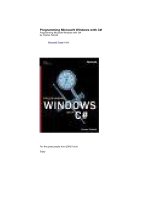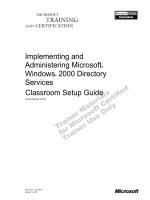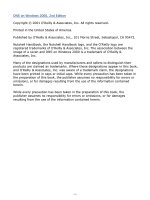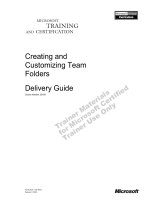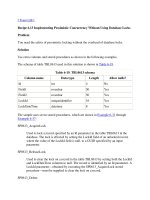Tài liệu Implementing Microsoft® Windows® 2000 Clustering Delivery Guide pdf
Bạn đang xem bản rút gọn của tài liệu. Xem và tải ngay bản đầy đủ của tài liệu tại đây (173.21 KB, 14 trang )
Part Number: X05-99749
Course Number: 2087A
Released: 12/2000
Delivery Guide
Implementing Microsoft®
Windows® 2000
Clustering
Information in this document is subject to change without notice. The names of companies,
products, people, characters, and/or data mentioned herein are fictitious and are in no way intended
to represent any real individual, company, product, or event, unless otherwise noted. Complying
with all applicable copyright laws is the responsibility of the user. No part of this document may
be reproduced or transmitted in any form or by any means, electronic or mechanical, for any
purpose, without the express written permission of Microsoft Corporation. If, however, your only
means of access is electronic, permission to print one copy is hereby granted.
Microsoft may have patents, patent applications, trademarks, copyrights, or other intellectual
property rights covering subject matter in this document. Except as expressly provided in any
written license agreement from Microsoft, the furnishing of this document does not give you any
license to these patents, trademarks, copyrights, or other intellectual property.
2000 Microsoft Corporation. All rights reserved.
Microsoft, Active Directory, BackOffice, Jscript, PowerPoint, Visual Basic, Visual Studio, Win32,
Windows, Windows NT are either registered trademarks or trademarks of Microsoft Corporation
in the U.S.A. and/or other countries.
Other product and company names mentioned herein may be the trademarks of their respective
owners.
Program Manager: Don Thompson
Product Manager: Greg Bulette
Instructional Designers: April Andrien, Priscilla Johnston, Diana Jahrling
Subject Matter Experts: Jack Creasey, Jeff Johnson
Technical Contributor: James Cochran
Classroom Automation: Lorrin Smith-Bates
Graphic Designer: Andrea Heuston (Artitudes Layout & Design)
Editing Manager: Lynette Skinner
Editor: Elizabeth Reese
Copy Editor: Bill Jones (S&T Consulting)
Production Manager: Miracle Davis
Build Manager: Julie Challenger
Print Production: Irene Barnett (S&T Consulting)
CD Production: Eric Wagoner
Test Manager: Eric R. Myers
Test Lead: Robertson Lee (Volt Technical)
Creative Director: David Mahlmann
Media Consultation: Scott Serna
Illustration: Andrea Heuston (Artitudes Layout & Design)
Localization Manager: Rick Terek
Operations Coordinator: John Williams
Manufacturing Support: Laura King; Kathy Hershey
Lead Product Manager, Release Management: Bo Galford
Lead Technology Manager: Sid Benavente
Lead Product Manager, Content Development: Ken Rosen
Group Manager, Courseware Infrastructure: David Bramble
Group Product Manager, Content Development: Julie Truax
Director, Training & Certification Courseware Development: Dean Murray
General Manager: Robert Stewart
Course Number: 2087A
Part Number: X05-99749
Released: 12/2000
Implementing Microsoft® Windows® 2000 Clustering iii
Contents
Introduction
Course Materials 2
Prerequisites 3
Course Outline 4
Microsoft Certified Professional Program 6
Facilities 8
Module 1: Introduction to Windows Clustering
Overview 1
Defining Clustering Features 2
Introducing Application Architecture 4
Identifying Availability and Scalability Requirements 6
Introducing Microsoft Windows 2000 Clustering 13
Comparing Network Load Balancing to Cluster Service 18
Identifying the Application and Service Environments 19
Discussion: Evaluating Business Scenarios 21
Review 27
Module 2: Concepts of Server Clusters
Overview 1
Introduction to Server Clusters 2
Multimedia: Microsoft Windows 2000 Cluster Service 7
Key Concepts of a Server Cluster 9
Demonstration: Cluster Concepts 26
Choosing a Server Cluster Configuration 27
Applications and Services on Server Clusters 36
Review 44
Module 3: Preparing for Cluster Service Installation
Overview 1
Pre-Installation Requirements 2
Identifying Hardware Considerations 8
Assigning IP Addresses Within a Cluster 16
Assigning Names Within a Cluster 18
Determining Domain Considerations 20
Existing Services and Applications 23
Lab A: Configuring Advanced Server for Cluster Installation 24
Review 31
Module 4: Installing Cluster Service
Overview 1
Installing Cluster Service 2
Post-Installation 10
Lab A: Installing Cluster Service 16
Review 23
iv Implementing Microsoft® Windows® 2000 Clustering
Module 5: Cluster Administration
Overview 1
Administration Tools 2
Configuring the Cluster Properties 9
Creating a Group 15
Creating a Cluster Resource 17
Failover and Failback 21
Lab A: Creating Cluster Resources 27
Review 33
Module 6: Creating Cluster Resources
Overview 1
Creating a File Share Resource 2
Lab A: Creating Cluster File Shares 7
Creating a Cluster Print Share 15
Lab B: Creating a Print Share 20
Configuring Clustered Applications and Services 26
Using Cluster Application Wizard 31
Lab C: Creating a WINS Resource 32
Review 36
Module 7: Server Cluster Maintenance and Troubleshooting
Overview 1
Cluster Maintenance 2
Troubleshooting Cluster Service 11
Lab A: Cluster Maintenance 24
Review 30
Module 8: Concepts of A Network Load Balancing Cluster
Overview 1
Network Load Balancing Concepts 2
Application and Service Environment 8
Network Load Balancing Functionality 12
Network Load Balancing Architecture 19
Lab A: Planning an Installation 31
Review 36
Module 9: Installing and Configuring Network Load Balancing
Overview 1
Pre-Installation 2
Network Load Balancing Driver Installation 7
Configuring the Network Load Balancing Driver 8
Cluster Parameters 9
Host Parameters 13
Port Rules 15
TCP/IP Properties 23
Post-Installation Configuration 25
Lab A: Installing and Configuring the Network Load Balancing Driver 27
Review 44
Implementing Microsoft® Windows® 2000 Clustering v
Module 10: Network Load Balancing Cluster Administration
Overview 1
Command Line Administration 2
Programmatic Management Solutions 11
Demonstration: Examining and Executing Scripts 18
Microsoft Application Center 2000 20
Lab A: Network Load Balancing Administration 21
Review 31
Module 11: Troubleshooting a Network Load Balancing Cluster
Overview 1
Using Status Tools and Utilities 2
Troubleshooting Problems 13
Using Network Tools and Utilities 16
Lab A: Network Load Balancing Cluster Troubleshooting 21
Review 27
Module 12: Microsoft Windows 2000 Clustering
Overview 1
Application of Clustering Technology 2
Testing Tools 4
Discussion: Implementing Clustering Technologies 6
Lab A: Implementing an N-Tiered Clustering Solution 8
Review 13
Appendix
Job Aid: Pre-installation Checklist
Job Aid: Cluster Commands
Planning Worksheet Module 8
Planning Worksheet Module 9 - Exercise 4
Planning Worksheet Module 9 - Exercise 5
Planning Worksheet Module 12
Implementing Microsoft® Windows® 2000 Clustering vii
About This Course
This section provides you with a brief description of the course, audience,
suggested prerequisites, and course objectives.
Description
This course provides the student with the skills to select the appropriate
implementation of business solutions requiring fault tolerance and high
availability. At the completion of this course, the student will be able to select
and implement Microsoft
® Windows® 2000 clustering solutions based on
Microsoft Cluster service and Network Load Balancing service.
Audience
The target audience for this course includes Information Technology (IT)
Professionals who have completed the core Windows 2000 curriculum or have
equivalent experience. The typical student:
Has completed or is working towards completion of the Microsoft Certified
Systems Engineer (MCSE) certification track.
Requires skills associated with planning, implementing, administering, and
troubleshooting Windows 2000 clustering solutions.
Is associated with organizations that need to provide access to services or
data in a high availability environment.
Is associated with an organization that needs to provide access to services or
data for large user populations.
Student Prerequisites
This course requires that students meet the following prerequisites:
Have completed or are working towards completion of the MCSE
certification track.
This course requires that students have completed Course 2153A,
Implementing a Microsoft Windows 2000 Network Infrastructure, or
equivalent knowledge, or Course 1560B, Updating Support Skills from
Microsoft Windows NT 4.0 to Microsoft Windows 2000, or equivalent
knowledge.
Course Objectives
After completing this course, the student will be able to:
Describe Windows 2000 clustering fundamentals including Cluster service,
Network Load Balancing and Component Load Balancing.
Identify key concepts of Windows 2000 Cluster service.
Identify hardware and network requirements and configure a computer
running Windows 2000 Advanced Server in preparation for Cluster service
installation.
Install Microsoft Cluster service, identify changes to the operating system,
locate key cluster service files and describe their function.
Create cluster resources by using the Cluster Administration tools.
viii Implementing Microsoft® Windows® 2000 Clustering
Modify existing Cluster service resources by using administrator tools.
Back up and restore a server cluster, and analyze and resolve Cluster service
faults.
Plan the implementation of a Network Load Balancing cluster.
Install and configure a Network Load Balancing cluster.
Perform administration tasks on a Network Load Balancing cluster.
Analyze and resolve Network Load Balancing cluster faults.
Describe how to use Network Load Balancing and Cluster service in a real-
world scenario.
Implementing Microsoft® Windows® 2000 Clustering ix
Course Timing
The following schedule is an estimate of the course timing. Your timing may
vary.
Day 1
Start End Module
9:00 9:30 Introduction
9:30 11:00 Module 1
11:00 11:15 Break
11:15 12:00 Module 2
12:00 1:00 Lunch
1:00 1:45 Module 2
1:45 2:45 Module 3
2:45 3:00 Break
3:00 3:15 Module 3 Lab
3:15 3:45 Module 4
3:45 4:15 Module 4 Lab
4:15 4:30 Review and Summary
Day 2
Start End Module
9:00 10:30 Module 5
10:30 11:00 Break
11:00 11:15 Module 5 Lab
11:15 12:15 Module 6
12:15 1:15 Lunch
1:15 2:00 Module 6 Labs
2:00 2:45 Module 7
2:45 3:00 Module 7 Labs
3:00 3:15 Break
3:15 4:45 Module 8
4:45 5:00 Review and Summary
x Implementing Microsoft® Windows® 2000 Clustering
Day 3
Start End Module
9:00 9:45 Module 8 Lab
9:45 10:45 Module 9
10:45 11:00 Break
11:00 11:15 Module 9 Lab
11:15 12:00 Module 10
12:00 1:00 Lunch
1:00 1:30 Module 10 Lab
1:30 2:00 Module 11
2:00 2:15 Break
2:15 2:30 Module 11 Lab
2:30 2:45 Module 12
2:45 3:30 Module 12 Lab
3:30 4:00 Summary and Review
Implementing Microsoft® Windows® 2000 Clustering xi
Trainer Materials Compact Disc Contents
The Trainer Materials compact disc contains the following files and folders:
Default.htm. This file opens the Trainer Materials Web page.
Readme.txt. This file contains a description of the compact disc contents and
setup instructions in ASCII format (non-Microsoft Word document).
2087A_ms.doc. This file is the Manual Classroom Setup Guide. It contains
the steps for manually installing the classroom computers.
2087A_sg.doc. This file is the Classroom Setup Guide. It contains a
description of classroom requirements, classroom configuration, instructions
for using the automated classroom setup scripts, and the Classroom Setup
Checklist.
Errorlog. This folder contains a template that is used to record any errors
and corrections that you find in the course.
Fonts. This folder contains fonts that are required to view the Microsoft
PowerPoint
® presentation and Web-based materials.
Mplayer. This folder contains files that are required to install Microsoft
Windows Media
™
Player.
Powerpnt. This folder contains the PowerPoint slides that are used in this
course.
Pptview. This folder contains the PowerPoint Viewer, which is used to
display the PowerPoint slides.
Studentcd. This folder contains the Web page that provides students with
links to resources pertaining to this course, including additional reading,
review and lab answers, lab files, multimedia presentations, and course-
related Web sites.
Tprep. This folder contains the Trainer Preparation Presentation, a narrated
presentation that explains the instructional strategy for the course and
presentation tips and caveats. To open the presentation, on the Trainer
Materials Web page, click Trainer Preparation Presentation.
xii Implementing Microsoft® Windows® 2000 Clustering
Student Materials Compact Disc Contents
The Student Materials compact disc contains the following files and folders:
Default.htm. This file opens the Student Materials Web page. It provides
you with resources pertaining to this course, including additional reading,
review and lab answers, lab files, multimedia presentations, and course-
related Web sites.
Readme.txt. This file contains a description of the compact disc contents and
setup instructions in ASCII format (non-Microsoft Word document).
AddRead. This folder contains additional reading pertaining to this course.
Answers. This folder contains answers to any questions in the modules and
hands-on labs.
Fonts. This folder contains fonts that are required to view the Microsoft
PowerPoint
® presentation and Web-based materials.
Labfiles. This folder contains files that are used in the hands-on labs. These
files may be used to prepare the student computers for the hands-on labs.
Media. This folder contains files that are used in multimedia presentations
for this course.
Mplayer. This folder contains files that are required to install Microsoft
Windows Media
™
Player.
Pptview. This folder contains the PowerPoint Viewer, which is used to
display the PowerPoint presentations that accompany the additional reading.
Webfiles. This folder contains the files that are required to view the Student
Materials Web page.
Wordview. This folder contains the Word Viewer that is used to view any
Word document (.doc) files that are included on the compact disc.
Implementing Microsoft® Windows® 2000 Clustering xiii
Document Conventions
The following conventions are used in course materials to distinguish elements
of the text.
Convention Use
Indicates an introductory page. This symbol appears next
to a topic heading when additional information on the
topic is covered on the page or pages that follow it.
Bold Represents commands, command options, and syntax that
must be typed exactly as shown. It also indicates
commands on menus and buttons, dialog box titles and
options, and icon and menu names.
Italic In syntax statements or descriptive text, indicates
argument names or placeholders for variable information.
Italic is also used for introducing new terms, for book
titles, and for emphasis in the text.
Title Capitals Indicate domain names, user names, computer names,
directory names, and folder and file names, except when
specifically referring to case-sensitive names. Unless
otherwise indicated, you can use lowercase letters when
you type a directory name or file name in a dialog box or
at a command prompt.
ALL CAPITALS Indicate the names of keys, key sequences, and key
combinations — for example, ALT+SPACEBAR.
monospace
Represents code samples or examples of screen text.
[ ] In syntax statements, enclose optional items. For example,
[filename] in command syntax indicates that you can
choose to type a file name with the command. Type only
the information within the brackets, not the brackets
themselves.
{ } In syntax statements, enclose required items. Type only
the information within the braces, not the braces
themselves.
| In syntax statements, separates an either/or choice.
Indicates a procedure with sequential steps.
In syntax statements, specifies that the preceding item may
be repeated.
.
.
.
Represents an omitted portion of a code sample.
THIS PAGE INTENTIONALLY LEFT BLANK

